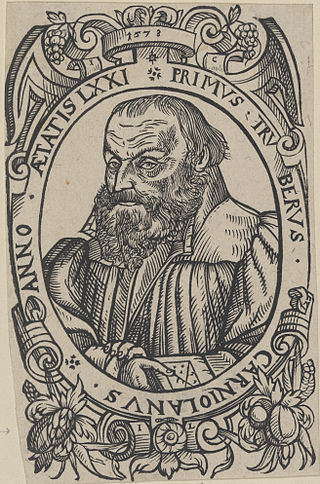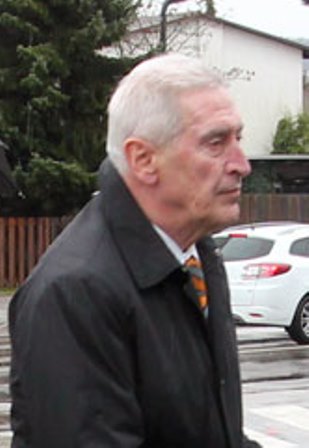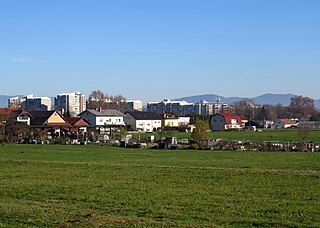
Ljubljana is the capital and largest city of Slovenia, located along a trade route between the northern Adriatic Sea and the Danube region, north of the country's largest marsh, inhabited since prehistoric times. It is the country's cultural, educational, economic, political and administrative center and the seat of Urban Municipality of Ljubljana.

Primož Trubar or Primus Truber was a Slovene Protestant Reformer of the Lutheran tradition, mostly known as the author of the first Slovene language printed book, the founder and the first superintendent of the Protestant Church of the Duchy of Carniola, and for consolidating the Slovenian language. Trubar introduced The Reformation in Slovenia, leading the Austrian Habsburgs to wage the Counter-Reformation, which a small Protestant community survived. Trubar is a key figure of Slovenian history and in many aspects a major historical personality.

Anton Aškerc was a Slovenian poet and Roman Catholic priest who worked in Austria, best known for his epic poems.

Maximilian Fabiani, commonly known as Max Fabiani was an Italian architect, born in the village of Kobdilj near Štanjel on the Karst Plateau, County of Gorizia and Gradisca, in present-day Slovenia. Together with Ciril Metod Koch and Ivan Vancaš, he introduced the Vienna Secession style of architecture in Slovenia.

Zoran Janković is a Slovenian businessman and politician serving as Mayor of Ljubljana since April 2012. He previously served as mayor from 2006 to 2011.

Ljubljana Castle is a castle complex standing on Castle Hill above downtown Ljubljana, the capital of Slovenia. It is a key landmark of the town. Originally a medieval fortress, it was probably constructed in the 11th century and rebuilt in the 12th century. It acquired its present outline with an almost complete overhaul in the 15th century, whereas the majority of the buildings date to the 16th and 17th centuries. Initially a defense structure and since the first half of the 14th century the seat of the lords of Carniola, it was since the early 19th century used for various other purposes and today is used as a major cultural venue.

Ivan Hribar was a Slovene and Yugoslav banker, politician, diplomat and journalist. During the start of the 20th century, he was one of the leaders of the National Progressive Party, and one of the most important figures of Slovene liberal nationalism. Between 1896 and 1910, he was the mayor of Ljubljana, and greatly contributed to its rebuilding and modernisation after the 1895 earthquake.
Jurij Gering was a politician in Slovenia during the first half of the 16th century when it was under the Holy Roman Empire. He became mayor of Ljubljana in 1524. He was succeeded by Pongrac Lustaller in 1526.

Lenard Chroen was a 16th-century politician in Slovenia when the country was under the Holy Roman Empire. He became mayor of Ljubljana in 1565. He was succeeded by Mihael Vodapiuez in 1567. He was father of the princebishop Thomas Chroen of Ljubljana.
Gaspar Hoffstetter was a 16th-century politician in Slovenia when the country was under the Holy Roman Empire. He became mayor of Ljubljana in 1574 and in serving a period of eight years became one of the longest serving mayors of the city. It is hard to tell whether he was popular or not, as with the then common lack of records. He was succeeded by Marko Stetner in 1582.
Jurij Viditsch was a politician of the early 17th century in Slovenia when the country was under the Holy Roman Empire. He was the Stadtrichter of Laibach (Ljubljana) in 1613, 1614, 1617 and 1618. He served as mayor of the city in 1624. He received the mayor's annual salary of 50 guilders in June 1625 retroactively, as was the custom at that time. He became mayor again in 1630.
Janez Jernej Bosio was a politician of the 17th century in Slovenia, when the country was under the Holy Roman Empire. He became mayor of Ljubljana in 1679 and served for a period of nine years, making him one of the longest serving mayors of the city. He was succeeded by Gabriel Eder in 1688.
Gabriel Eder was a politician of the late 17th century in Slovenia, when the country was under the Holy Roman Empire. He first became mayor of Ljubljana in 1688. He was then succeeded by Janez Dolnitscher in 1692, but was remade mayor again in 1702, serving until 1710. In total he served 12 years as mayor, one of the longest in the history of Ljubljana.
Matevž Fran Beer was a politician of the 18th century in Slovenia, when the country was under the Holy Roman Empire. He became mayor of Ljubljana in 1751 and was one of the longest serving mayors in the history of the city with a term of 13 years. He was succeeded by Fran Gamba in 1764.
Anton Fran Wagner was a politician of the 18th century in Slovenia, when the country was under the Holy Roman Empire. He became mayor of Ljubljana in 1775. He was succeeded by Janez Friderik Egger in 1782. During his tenure he was also a pharmacist.
Josip Kokail was a politician of the late 18th and early 19th century in Slovenia, when the country was under the Holy Roman Empire. He became mayor of Ljubljana in 1797 and became the second-longest-serving mayor in the history of the city, serving a term of 15 years. He was succeeded by Anton Codelli in 1812.

The architecture of Slovenia has a long, rich and diverse history.

Aleš Čerin is a Slovenian businessman and a politician. In 1973, he graduated from law at the University of Ljubljana. He was the Secretary-General of the Government of the Republic of Slovenia from 1986 until 1992, during the Slovenian proclamation of independence in 1991. Starting in 1992, he worked in the retail company Mercator, and was made a member of its executive board from 1997 until 2005. He was elected to the city council of the Urban Municipality of Ljubljana in October 2006 as a member of the Zoran Janković List and was named by Janković a deputy mayor of the municipality.

Fužine is a formerly independent settlement southeast of the capital Ljubljana in central Slovenia. It belongs to the City Municipality of Ljubljana. It is part of the traditional region of Lower Carniola and is now included with the rest of the municipality in the Central Slovenia Statistical Region.











